
At Tainan’s historic Confucius Temple

At Tainan’s historic Confucius Temple
The Presidential Office Building of Taipei is a broad, elegant building with a stately tower and Corinthian pillars. Built during Japanese rule, it faces east to meet the rising sun, before a long esplanade and the beginning of a multilane avenue. But on March 22, 2004, that stretch of pavement and much of the road behind it was swarming with protestors.
Two days before, President Chen Shui-bian of the Democratic Progressive Party was elected to his second term in office. A day before that, he was waving to supporters in a cavalcade when a bullet grazed him. He won the election, held in the frenzied aftermath of the incident, with a margin of .2 percent of the vote. Now the losing party, the Kuomintang, was holding an impassioned “sit-in” at the Presidential Building, refusing to leave even through rain and nights.
Men and women draped in plastic ponchos yelled and pumped fists as a speaker on a microphone led them. I squirmed through the crowds to get a better look at the stage that had been erected before the palace, grasping at my friends’ hands just ahead. There was a line that snaked into the audience from the stage, where people were waiting their turn on the mic. Folding chairs and blankets all across the pavement reaffirmed the voices urging people to camp out overnight. Many had the night before. As I finally walked up to my group of fellow students, I was distracted by a protest organizer handing out a very important ration. With a white-gloved hand and a mask covering her face, she shoved a dome-shaped bun into my hand and moved right past me, doling them out to everyone else in sight. The familiar warm cabbagey smell of homemade dumplings wafted to my nostrils. I held the morsel—a basic shui jian bao, crisped on the bottom from a hot, oil-slicked pan, and steamed through to the swirled pinch at the top. How good could protest-rally food really be? I took a bite through the soft, delicate skin. Still warm, it burst with savory pork juice accented with white pepper and scallion. Of course it was good—this was Taiwan.

My brother and me at Chiang Kai-Shek Memorial Hall, 1988
I was studying abroad at a university in Taipei that spring. My friends and I were just onlookers that day, curious about what was taking place in the city. We’d taken the subway to the city center from our college’s neighborhood of Muzha in Taipei, after classes. We didn’t have any strong political beliefs, but I was becoming more aware of a rising political tension, underscored by a growing national identity and sense of Taiwanese pride during my short spring semester.
Taiwan had never been a home to me before then, but it’s where my mother was born and raised before moving to the States in her twenties. My parents had met in Taiwan in the 1970s, when my dad took a job with an import-export company based in Taipei. As a recent grad from Cornell who majored in Asian studies, my father spoke Chinese and could advise the company on Western customs, like what Santa Claus wears. My mother worked for the company, too; they met on my father’s first day on the job. After marrying, my parents eventually settled in New Jersey, after living at times in San Francisco and New York City. I never planned on spending a semester of college in Taiwan—and neither did anyone in my family. But when the opportunity to apply for a teach-study scholarship program in Taipei suddenly presented itself during my senior year of college, I just knew that I had to sign up. It would be for my last semester of college, but why not? There was no question about it; I just had to go.
The world of Taiwan—and especially its food—became three-dimensional to me almost from the moment I stepped off the plane. Suddenly, all the foods that I had grown up eating made so much sense to me. All the aromas and tastes were so much richer. And they were so varied! While I could recall my mother making stir-fries with slivered pork and vegetables as a go-to dinner routine at home, in Taiwan I got to taste the tender, gelatinous strips of pork belly and crisp, herbal Chinese celery tossed rapidly together in a smoking-hot wok. The Taiwanese fried chicken, its crackly, seasoned crust served atop rice and a drizzle of sauce, was something that I’d never encountered at home. Salty, soothing eggs dyed from a warm bath of soy sauce–based broth that I snacked on frequently as a child were available everywhere in Taiwan, in all different shades and sizes. One slurp of a beef noodle soup’s broth was practically enough protein for the day, so dense and satisfying it was—yet also so reminiscent of my mother’s weekend favorite red-braised beef stews. I delighted in visiting the night markets, which were all the rage among students, tasting something new around every corner: one night it might be a simple, yet beautifully prepared thick soup of fresh squid, and another, a crazy, chewy concoction with the likes of oysters and eggs folded together with a clear, starchy gel. Pretty soon I realized that I was eating fairly nonstop—and it seemed most people were as well. The sheer number of roadside restaurants, street carts, and night market vendors, and the passion with which people spoke of their favorites, indicated that Taiwan is an island obsessed with food. Good food, and all kinds of it.

My brother and me at Sun Moon Lake, 1988
Most of the experiences I had in Taiwan were punctuated by food. A trip to the coastal city of Danshui, for instance, meant tasting every local signature served by vendors along the waterfront. Breaks in between classes entailed grabbing snacks like crispy youtiao, a box of dumplings, or bento lunch and any number of iced, sweetened drinks. “Hanging out” simply meant eating, shopping, and the occasional karaoke booth session. It wasn’t just eating any old thing for an exciting night out, though. It could be a half-dozen or so stands at a night market, or a new and trendy shop specializing in steak, yakitori, Sichuan food, spaghetti, or hot pot. The emphasis on food in Taiwan was perfectly fine with me. Growing up, my family treated food as the focal point of any gathering, and a definite highlight of the day. Every night we sat around the table for family meals prepared by my mother, and often on weekends, by my father. It wasn’t always Chinese food, of course; my mom had learned with great enthusiasm how to cook American staples like meatloaf and barbecued chicken. For holidays, my parents would (and still do) take turns, my mother preparing an elaborate Chinese-style meal of many courses the night before Christmas or Thanksgiving, and my father preparing the requisite turkey, or prime rib, the next. There was nothing too strange to try when it came to exploring food, either. My family’s motto very much was: If it exists, then we’d like to try it. My father even kept a paper menu of his favorite Malaysian restaurant and would cross off dishes he’d tried in pencil. The next outing there, he’d place it in his pocket and unfold the menu to order only things that weren’t yet crossed off. I was beginning to realize, during my college years, that not every family in the States shared our borderline obsessions with food. In Taiwan, I felt like I’d found my homeland.
My grandparents, my uncle, and aunt had all moved to the States from Taiwan during my early childhood, so there had been no reason to visit the island ever since my first trip there at the age of six. Our family lost touch with what was going on in Taiwan throughout the eighties and nineties. They missed out on experiencing firsthand many of the transformations the island underwent in the meantime: the lift of martial law in 1987; the first democratically elected president in 1996; the lift on bans for direct mail and flights between mainland China and Taiwan in 2008; and the rise of other political parties that were not solely the KMT, like the Democratic Progressive Party.
Such things would have been unfathomable at the time when my mother’s parents had immigrated to Taiwan from Hunan Province in 1948—along with some two million people from throughout mainland China. This was during China’s civil war, when Mao Zedong’s People’s Republic of China (PRC) was gaining ground, forcing Chiang Kai-shek’s Republic of China (ROC) to retreat to the island. Their plan was to stay in Taiwan only temporarily, to regroup and gather the strength to take back their country. Things didn’t turn out the way the ROC would have liked, and they’ve remained based in Taiwan ever since.
My grandparents never imagined they’d be planting their roots in Taiwan; to them it was a mere stopover, an unfortunate hiccup in the war. But had my mother and her generation been born and raised in mainland China instead of Taiwan, her life would have been a whole different story. I was just beginning to see exactly where she came from, and what aspects of her unique homeland I’d inherited from her while living in Taiwan that spring of 2004.
A Slippery “Status-Quo”
Now, we understand that the shootings that took place in March 2004 had been a sincere assassination attempt on the president by an individual acting alone. The suspect was never charged as he committed suicide before being discovered. The former president Chen Shui-bian was incarcerated after completing his second term on charges of embezzlement, however. Currently, the reigning president of Taiwan is the Kuomintang (KMT) leader Ma Ying-jeou, who has garnered controversy for appearing to be more cooperative with Beijing than former Taiwanese leaders. No one could have predicted all these things those impassioned days just after the election in 2004. Still, the protest was somewhat misguided; most of the people I spoke with at the sit-in and the days after in Taipei were upset because they thought the shootings were an elaborate hoax the president had staged in order to turn the election with sympathy votes. A long, flowing banner hanging onstage at the presidential palace rallies had read, “We want truth. We want justice.” Perhaps it goes much deeper than that. These protestors’ opposition to the president was rooted in a decades-old clash. On that same day, in the southern Taiwan city of Tainan, supporters of the Democratic Progressive Party were celebrating the reelection as a momentous sign of victory for the Taiwanese who had been on the island for generations, of which Chen was one. But in the KMT’s home base of Taipei, its supporters were just not willing to swallow the notion of not being the true leaders of Taiwan. And until just a few decades ago, they weren’t even willing to accept not being the true government of China. For their part, the Democratic Progressive Party’s message hinged on empowering the “true” Taiwanese people, who were oppressed by the various groups who ruled over them during the last two centuries. Although largely criticized for appealing to this angle without solid policy to back it up, the DPP and Chen have indeed invigorated a sense of Taiwanese identity and pride. Their call for independence has waxed and waned periodically throughout the last three decades in Taiwan—increasing tensions with the mainland that have at times prompted shows of military strength. “But as it stands, China still claims Taiwan is its territory, even though Taiwan is self-governed outside of Beijing rule.”
Indeed, I had stumbled upon Taiwan at a visceral stage of its identity crisis. And as far as we know, there had never really been a time on the island without one.
The Sunflower Student Movement
Ten years after the reelection of President Chen Shui-bian and the Taipei “sit-ins” afterward, Taiwan was embroiled in another passionate debate. In the spring of 2014, the Presidential Office Building was again teeming with protestors—this time, of a younger, college-age population, and they were singing a drastically different tune. Holding sunflowers as a sign of hope and occupying the presidential palace and its surrounding streets, these students were protesting a controversial trade deal between China and the ROC, called the Cross-Strait Service Trade Agreement. This “sit-in” lasted from March 18 to roughly April 10, after several rounds of negotiations between the ruling-party KMT and the DPP. The Democratic Progressive Party was aligned with the student rebellion’s concerns, which was that closer trade ties with China would make it more vulnerable toward political pressures from its neighbor. After weeks of negotiations during the occupation, an agreement was not reached, leaving the KMT to pursue its economic relationship with China. But in the months afterward, the Sunflower Movement was successful in reanimating an international conversation on the broader theme of Taiwan’s economic independence as a means of protecting its political independence from Beijing. This sentiment was expressed by Hillary Clinton in June 2014, in a statement she made to Business Weekly magazine. A wariness of China’s political oversight was also felt by the students and people of Hong Kong in the fall of 2014, who launched an occupation protesting elected leaders being vetted by Beijing, a protest that some speculate was inspired by Taiwan’s.
Is China Taiwan’s founding father or ultimate foe? A bullish presence and insult to Democratic agendas, or a great economic opportunity and cultural kin? Who am I to say? But some 100,000 protestors came out to these demonstrations in 2014, and although I was not there to witness them this time, much of the world took notice. Its significance cannot be underestimated for the future of the island.
The Birth of a Cuisine
There is something exciting about a culture that is just coming into its own. Politics aside, the idea of Taiwan as having a distinct and unified culture is a thesis that has been gaining support in recent years. Along with that, that Taiwan has a unified and distinct cuisine in and of itself; a cuisine that would have never been without the waves of migration and war, yet holds its own legacy.
One hallmark of national pride might just be its beef noodle soup, for instance. The dish bears resemblances to mainland Chinese cooking, yet is a treasured specialty of Taiwan. Another is Koxinga, the Ming Dynasty hero who formed the first independent state on Taiwan (who we’ll hear about later on in the History section). The diverse melting pot that makes up Taiwan’s population is also celebrated on the island as a point of distinction. While its national language is Mandarin, for train announcements in Taiwan, you’ll hear messages in Mandarin followed by repeats in Hokkien (the southern Taiwanese or “Taiwanese” dialect, rooted in Fujian province); Hakka (a traditionally oppressed and dispersed Chinese minority group, which Taiwan has significant populations of); and often a Taiwanese aboriginal dialect, depending on where you’re located. I have observed a burgeoning interest in traditional art and folk music from the fishermen, farmers, and tea pickers of Taiwan. Also, there is a surge of interest in preserving the cultures of the aboriginal tribes in Taiwan, with television stations devoted to this community and pop stars proudly claiming this heritage. This might seem almost contradictory to the open-armed stance that Taiwan places itself in the modern first world. The Taiwanese are quick to embrace the latest trends in popular culture from Western countries, South Korea, and Japan. Taiwan is eager to welcome tourists from around the world, to learn English, and to send its best students overseas. It is keen to import English-speaking students and teachers, if my academic sojourn in Taipei is any proof. And it has had a thoroughly democratic government since 1996.
Yet amid all the rage over international fashion, music celebrities, or the latest culinary import, there is a conspicuous interest in traditional Taiwanese cuisine. This is seen in restaurants such as Shin Yeh and Chingye Shinleyuan in Taiwan, which were both founded by female restauranteurs and have become legendary for their sophistication in old-fashioned Taiwanese cooking. It is also demonstrated in the popular BaoHaus bun shop in New York, where its outspoken Taiwanese-American chef Eddie Huang has popularized the Taiwanese brand of pork belly buns. Taiwanese cuisine has been explored in a book by Chen Jingyi, a Taiwanese writer who shined a spotlight on the history of famous dishes found throughout the island in loving detail. And also by Jade and Muriel Chen in Australia, restauranteurs who have published a cookbook that illuminates their unique culinary homeland. There have always been regional specialties throughout Taiwan, which are fiercely prided by locals and sought out by domestic travelers. But today, there is a growing chorus of thought on uniquely Taiwanese food as a whole.
What exactly is traditional Taiwanese cuisine? Like any place or peoples, it is rooted in humble peasant dishes. This bedrock gives itself away with the use of dried or fermented ingredients, or with offal cuts of meat, and homely, rough vegetables. It shows its slip whenever a dish so seemingly crude and inexpensive has become a source of immense pride and fondness, appearing even on banquet tables. It evolves when these beloved comfort dishes of a country are refined over time, improved upon and expanded in myriad ways by adoring cooks along the way. This is certainly the case for Taiwan’s favorite traditional foods, and it’s happening all the time and in different stages with newer beloved dishes.
When I set out to write a cookbook on the food of Taiwan, I had to keep asking myself, what makes this dish distinctly Taiwanese? Meaning, not something that’s merely a riff or extension of something that you’d find in some part of mainland China, nor an attempt at something from an even more far-flung locale (sorry, but Taiwanese pizza is not quite it). One way of looking at how a cuisine is created is to examine the social factors that led to its formation: the military camps where families from all over China mingled and cooked their meals and the small food businesses that cropped up around temples in Tainan, serving worshippers as they came and went. Geography and lifestyle figure heavily into this as well, with the influences of the coastal regions’ easy catches and the nine-to-five hustle-bustle of the average, largely middle-class workday. We will look at the social and recreational habits of modern-day Taiwanese, like night markets, to see where the cuisine might be evolving. Throughout the recipes, we’ll explore the quick meals served for commuters on the go and the ever-popular night market culture, where young people rush to the trendiest stalls. We’ll also take a closer look at the preferences in ingredients and texture concerning Taiwanese food today. Also, we’ll explore the ways in which overseas influences have found their way into food culture as part of the larger popular culture.

My grandparents and my mother, Taipei, circa 1951
Upon deciding to write a cookbook on the food of Taiwan, I hoped that this would only be the beginning of a larger dialogue. I don’t attempt to know every
intricacy nor history nor regional specialty, but to invite those conversations for the long run. It is an endless and ever expanding topic anyway, with new dimensions being built onto it as we speak. I also acknowledge that as an American-born, half-Taiwanese writer, this is absolutely not an exhaustive study nor the most intimate. But I will say that when deciding to write this book, it really comes down to this picture.
The proud, hopeful faces of my grandparents holding my infant mother are profound to me. I will never forget the courage and audacity that my forebears demonstrated when they decided to move away from their families to a strange island, in which their future was unknown.
There’s a saying in Taiwan that one is a “taro root” if they’re from Taiwan (because the shape of the root vegetable resembles the island’s shape), or they’re a “sweet potato leaf” if from mainland China (before the conquest of Manchuria, for shape reasons again). My grandparents would then be a sweet potato leaf in this equation. But no coincidence, these are food–based metaphors, and taro roots and sweet potato leaves are common items at the Taiwanese table. For reasons of universalizing this cuisine, I have focused largely on dishes that can be translated easily using similar ingredients found in America or focusing on those using ingredients that are already eaten and readily found here in the average grocery market. Locally-grown substitutions and adjustments are not a huge concern to me, having grown up with my mother’s cooking. In fact, substituting ingredients—with what is locally available—is emblematic of the many peoples who settled in Taiwan, as evidenced in the recipes throughout this book. Even still, tasty food traditions hold their own. When blended with environmental factors and cultural influences, something magical happens. This is exactly what I believe has happened with Taiwanese cuisine as a whole.
Taiwan has been inhabited by various aboriginal tribes for thousands of years. Yet only a hundred miles off the eastern coast of China, little was recorded about Taiwan and its inhabitants by even the Chinese empire until the modern era.
In 1544, a Portuguese ship passing by Taiwan named it Ilha Formosa, or Beautiful Island. Shortly afterward, the Spanish landed and found Taiwan to be a rich source of sulfur, an element in gunpowder. The Dutch arrived and established the Dutch East India Company outpost on Taiwan in 1624, trading sugar, spices, and silk. Their colony increased due to the profitable trade, and the Dutch built two forts, one in the north and the south of the island by the mid-1600s.
At this time in mainland China, the Ming Dynasty was overthrown by Manchurians, resulting in the Qing Dynasty. However, a leader of the Ming loyalists known as Koxinga (or Zheng Chenggong) carried on valiant efforts to oust the new dynasty and revive Ming rule. Koxinga and his troops were forced farther south by their opponents and in 1660 they decided to regroup on the island of Taiwan.
Koxinga is revered as a hero in Taiwan, and is even thought of as a founding father (especially in the south, where Tainan served as its first capital). The military leader had an unusual background: the son of a Chinese merchant and a Japanese woman, he was born and raised until the age of seven in Japan (a fact that the Japanese who would later colonize Taiwan would call attention to). Koxinga led many successful campaigns for the ultimately failing Ming dynasty, but the greatest achievement for which he is remembered is defeating Dutch rule on Taiwan. This was achieved in the Siege of Fort Zeelandia on the southwest coast of Taiwan in 1662, effectively forcing the Dutch out and gaining control of the island. However, Koxinga did not enjoy his victory long and died of malaria in the same year. His son continued the independent kingdom they established on Taiwan until he was defeated by the Qing Dynasty in 1683.
Afterward, more mainland Chinese began trickling over to Taiwan, mining for sulfur and other resources, but it was seen as dangerous terrain—rife with diseases and head-hunting aborigines. For these reasons, it didn’t attract much foreign interest until the end of the 1800s, when China lost the first Sino-Japanese War and ceded Taiwan to the Japanese empire. From 1895 to 1945, Japan occupied Taiwan.
Things got off to a very rough start between the existing communities on Taiwan and its Japanese rulers. Determined to make its sovereign territory profitable and extract its resources, the Japanese led ruthless campaigns against the aborigines, who receded to the mountains. They stamped out a short-lived resistance by the Taiwanese of Chinese heritage on the island. They built railroads and established the first education system on the island (its sovereign pupils would read, write, and learn in Japanese). They performed extensive scientific research to alleviate the risk of infectious disease. For much of the second half of the Japanese period, Taiwan was fairly peaceful. Older generations in Taiwan remember the period from their childhood as relatively good times, even, for the island. At least, in comparison with what happened next.
After the bombing of Hiroshima in 1945, Japan surrendered to the Allies, effectively ceding all its foreign colonies. Critically, however, they did not specify exactly whom they were ceding Taiwan to. And by then, the Qing Dynasty was no more. It had been overthrown by China’s first modern democracy in 1912, the Republic of China (ROC), led by Sun Yat-sen. But China remained in grip of civil war for decades afterward. After Sun died in 1925, Chiang Kai-shek of the Chinese Nationalist Party, or the Kuomintang, was appointed his successor. Sun believed in containing the disparate factions under the flag of the ROC, despite mounting tensions with Chinese Communists, or the People’s Republic of China (PRC). Chiang, however, wanted to defeat the Communists. By the late 1940s, the PRC, led by Mao Zedong, were forcing the Nationalists farther south, into Sichuan province. Chiang and his government sought temporary refuge on the island of Taiwan.
When the Kuomintang arrived in Taiwan in 1947, they did not tread lightly. The KMT military leader who led this mission, Chen Yi, persecuted thousands of innocent people who resisted the invasion. The incident, which began on February 28, 1947, is known today as the 2-2-8 massacre. Chiang Kai-shek, his entire army and its dependents, and many supporters of the ROC constituting 1.5 to 2 million people in total, moved from the mainland to Taiwan from 1948–1949. Martial law was declared on the island.
Initially, the Republic of China was recognized internationally as the true government of China, in exile on Taiwan. As the decades passed and they were still unable to challenge the Communists on the mainland, this attitude changed. The ROC lost its seat in the UN to the PRC in 1971. In 1972, President Nixon visited Beijing, a gesture that was viewed as acknowledging the PRC’s legitimacy as China’s government. Meanwhile, on Taiwan the KMT government implemented a land reform program that is viewed by experts as a great success. As farmers enjoyed better security, industries grew, the middle class flourished, and the island enjoyed greater prosperity through the 1960s and 70s. Chiang Kai-shek’s son succeeded his father in 1975 and continued single-party rule, although he lifted martial law in 1987. Before his death in 1988, he appointed Lee Teng-hui as the next president of the ROC. Lee was the first Taiwan-born president and a skilled, Japanese-educated economist. He led the island through an economic boom, fueled by Taiwan’s high-tech industry. Lee established greater democracy throughout his presidency, allowing new political parties to be formed, and dismantling superfluous branches of the government designed by the KMT under the assumption that it ruled China.
In 1996, Lee won reelection in the island’s first true presidential elections. Since then, economic growth has been slower on the island, but it has established a national health insurance system, social welfare programs, and has made progress in educational standards. Today, 95 percent of Taiwanese students complete high school and go on to trade school or college. The Taipei World Financial Center, or Taipei 101, was built in 2004 and for five years enjoyed the status of the world’s tallest building. In 2000, Chen Shui-bian of the Democratic Progressive Party won Taiwan’s second democratic election. Ma Ying-jeou of the Kuomintang won election in 2008, and serves as Taiwan’s current president.
Image Gallery
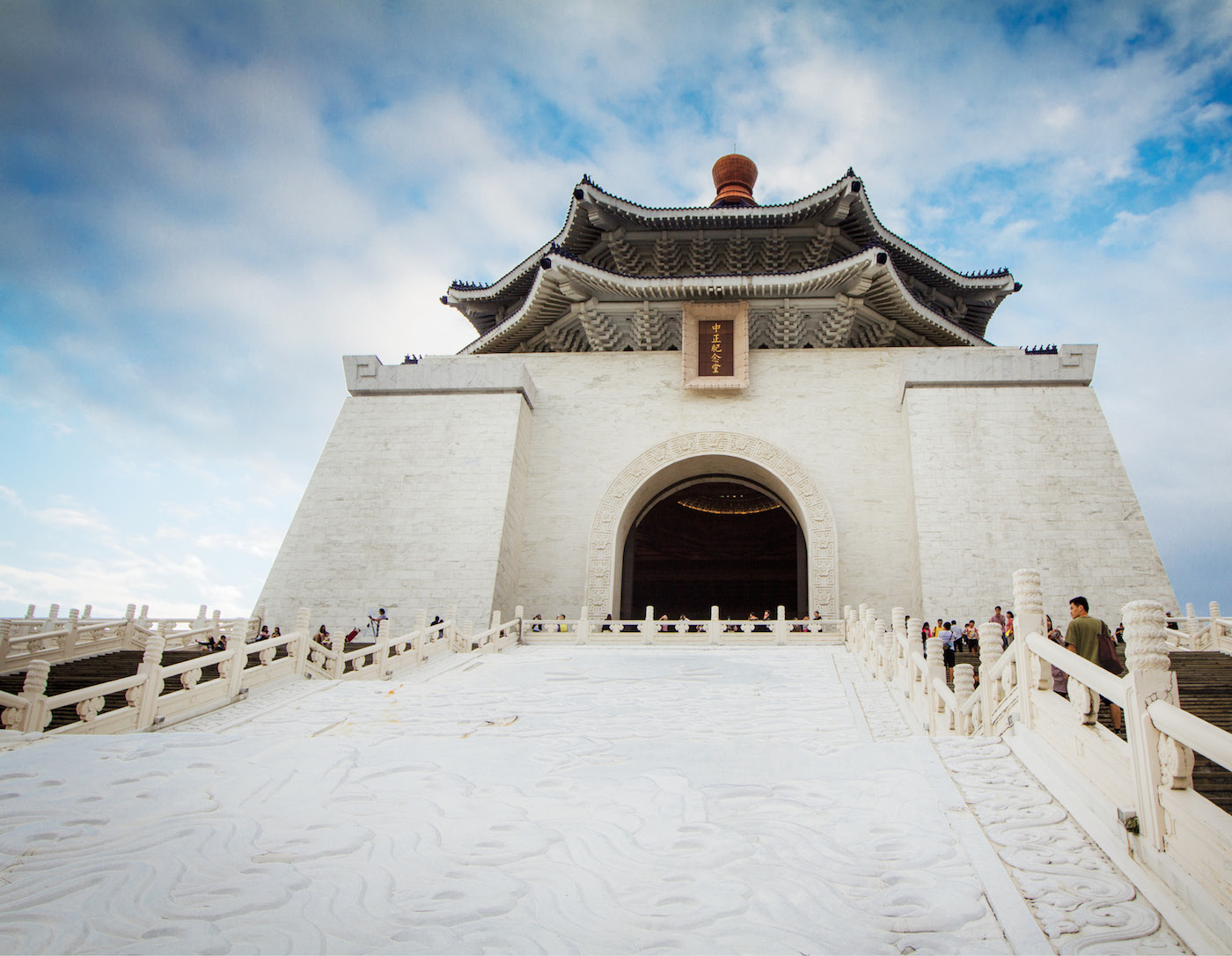
Chiang Kai-Shek Memorial in Taipei
Image Gallery

The gardens of the historic Confucius Temple of Tainan
Image Gallery

A statue of the Ming leader Koxinga in Tainan
Image Gallery

A tea farmer in Maokong, which overlooks Taipei
Image Gallery

A view of Taipei from the mountains
Taiwan’s diverse population is greatly prided on the island. A land of 23.3 million, its people can be divided roughly into four major groups, although intermarriage makes it impossible to designate exact numbers to each. A majority of Taiwanese are of Hoklo descent, originally from Fujian Province in China. These are descendants of people who immigrated across the Taiwan Strait before the Japanese takeover in 1895. Their populations are most prominent in the southern counties of Taiwan, where Taiwan’s capital was situated before the northern city of Taipei was named its capital as a state under the Qing Dynasty in 1886.
The mainland Chinese people who settled in Taiwan in the late 1940s were a varied group. In addition to soldiers and their families, about a million civilians traveled along with the ROC from all throughout China. Many of them were scholars, musicians, Buddhist monks, businessmen—people who were wary of the Communist regime. These also included China’s minority groups such as Muslims and Mongolians.
Taiwan’s aboriginal tribes account for 2 percent of its population, roughly half a million people, and are divided among fourteen officially recognized tribes. There are numerous unrecognized tribes, as well as efforts to preserve their languages and culture on the island. Many distinct tribes in Taiwan became extinct or were assimilated into other tribes over the years due to war and oppression. Anthropologists have categorized Taiwan’s aboriginals as Austronesian peoples, an ethnic group of Southeast Asia and Oceania found in regions as far-flung as Madagascar and Hawaii. They are also the majority ethnic group of Malaysia and the Philippines. As such, they are not of China’s majority ethnic group, Han Chinese.
The Hakka people are dispersed throughout China and the world, and constitute another large group on Taiwan. The Hakka began settling in Taiwan in the 1800s to escape oppression on the mainland. Once thought to be a distinct ethnicity, the Hakka are now widely recognized as Han Chinese, yet they have their own language and customs. The Hakka are known as a hardworking people, establishing agricultural communities in less desirable areas of Taiwan. A wonderful cookbook of the rustic cuisine of the Hakka diaspora was published in 2012 by Linda Lau Anusasananan.
Taiwan’s legacy as a haven for the oppressed or the opportunistic continues. There have been recent waves of migration from Southeast Asian countries, many of them women seeking domestic work. Businessmen and expats from other foreign countries comprise about 5 percent of Taiwan’s current residents.
Despite these foreign migrations, Taiwan’s population is projected to decrease. Following a postwar birth boom in the 1950s and 60s, Taiwan’s birth rate has gradually declined. It dropped below the replacement level (needed to replace the current population) in the 1980s, and in 2010, Taiwan held the lowest birth rate in the world. Many have speculated the shrinking numbers are attributed to education, overseas travel, relocation, and a career-focused female population.
Image Gallery

Folk singer Ha Wan and Chef Chen Yao-Zhong, both of the Amis tribe
Image Gallery
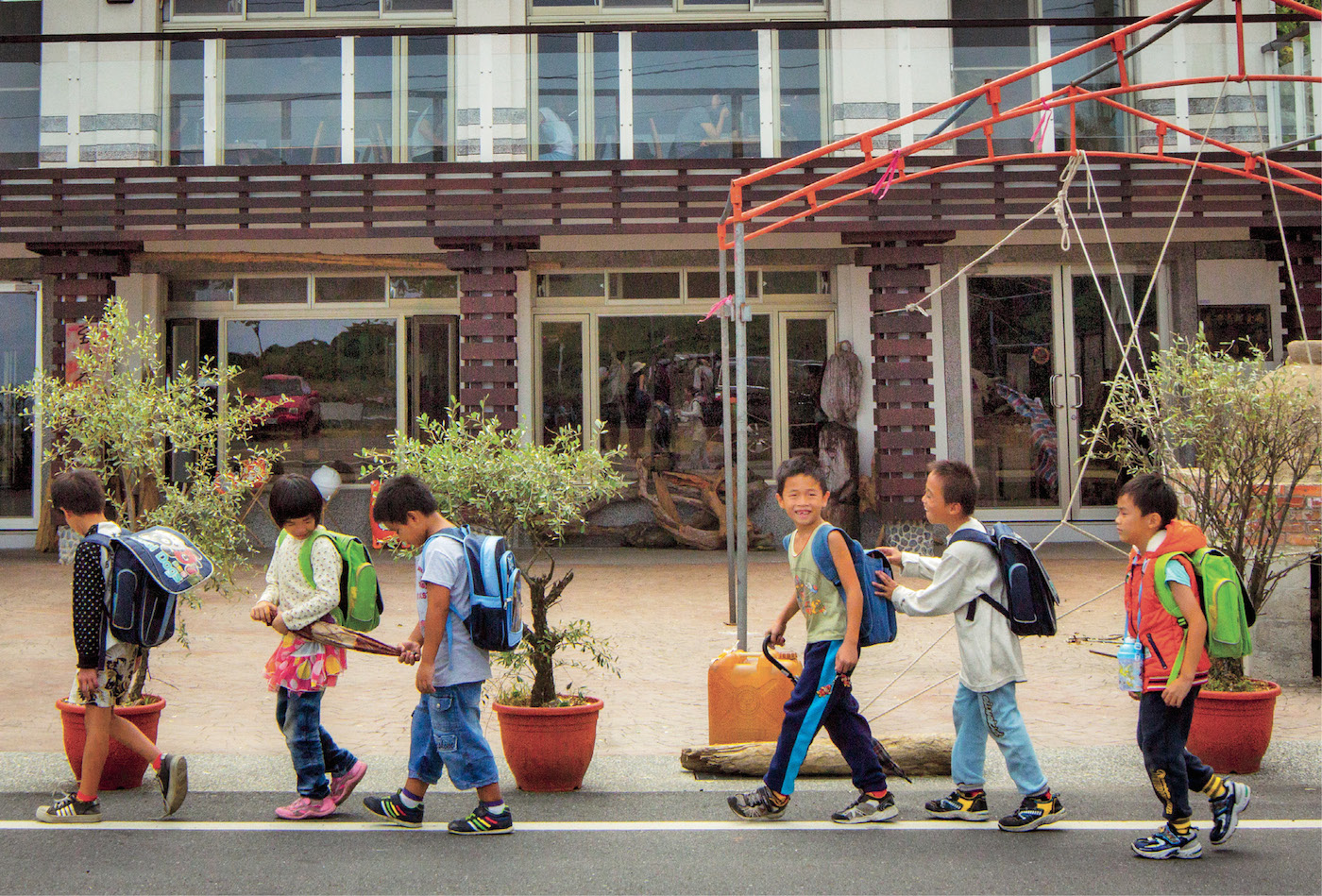
Children walking home from school
Image Gallery

Young drummers of the Paiwan tribe in traditional dress
Image Gallery

A family meal served at home
Image Gallery

A Buddhist monk amidst the crowd
Image Gallery
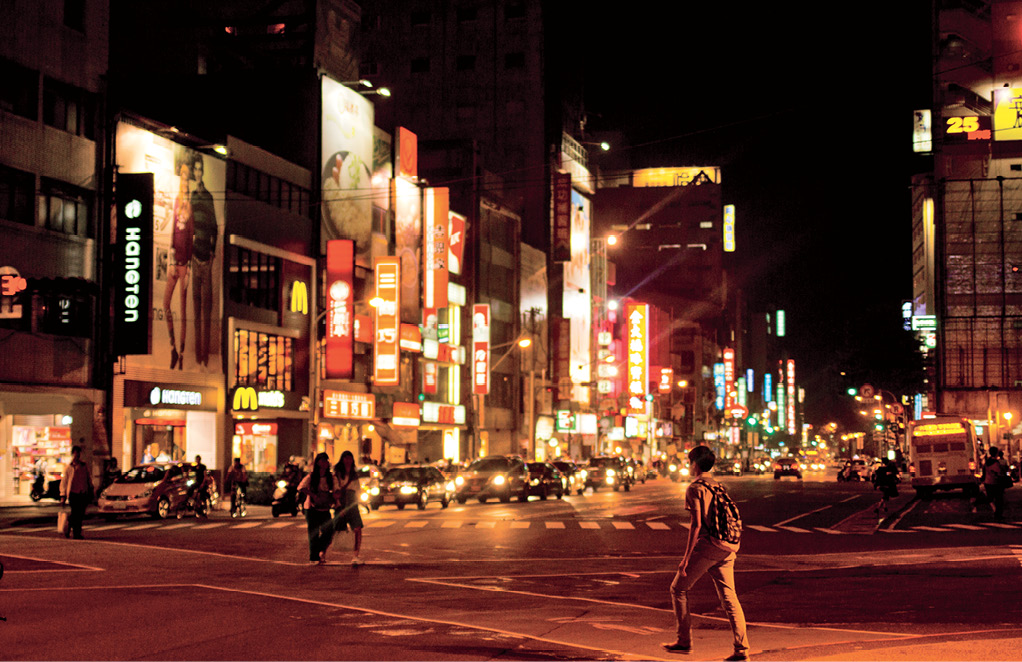
A cosmopolitan strip in the city of Kaoshiung
Image Gallery

Vendors chatting in an alley before business hours
Image Gallery

A fun restaurant outing
Image Gallery

Cooks tools
Image Gallery

Shopping for groceries in a day market
An island of 35,883 square kilometers, Taiwan sits just off the eastern coast of China, to the south of the Japanese archipelago, and to the north of the Philippines. It has a subtropical climate, spanning the Tropic of Cancer. More than 50 percent of Taiwan is covered with wooded forest and jungle. Its east is mostly mountainous, with five mountain ranges running alongside the eastern coast. The lowlands of Taiwan’s west and north are populated rather evenly, with cities alongside the west from north to south. The Penghu Islands, or the Pescadores, lie to the southwest and are part of Taiwan. Taiwan experiences rainy seasons in the winter and a summer monsoon, and has an overall hot, humid climate. Among Taiwan’s unique natural resources are its hot springs. Thanks to a tectonic plate collision zone underneath, warm, clear water swells from four major locations in Taiwan and are enjoyed as spas. Taiwan is prone to earthquakes and typhoons due to its unique geography, as well.
Taiwan is home to incredible natural landscapes, from lush mountains to fantastic coastal rock formations. There are eight government-protected national parks throughout Taiwan, and thirteen national scenic areas (the latter promoted by the tourism bureau). These reserves are home to diverse wildlife and fauna, and often aboriginal communities. Major destinations for visitors include natural spectacles like Taroko Gorge and Sun Moon Lake, the mountain range Yangminshan, and the coral reefs of Kenting.
Taiwan is well suited for growing sugarcane and rice. These industries had been established on the island as early as the Dutch rule, and continued to be important agricultural exports. Specialty crops like tropical fruits and high-mountain teas are major exports today as well. Taiwan is world renowned for producing some of the most distinctive tea, grown in its mountainous terrain. With only one-quarter of its land suitable for agriculture, however, and with slowing domestic demand due to joining the WTO in 2001, Taiwan’s farmland has been gradually decreasing.
Surrounded by coasts, Taiwan has a well-established fishing industry. Coastal regions are predominantly fishing communities, supplying the island’s massive appetite for all manners of seafood. One can spot a temple dedicated to the Taoist goddess of the sea—the fishermen’s god—poking from the hilltops in most of the coastal towns and cities throughout Taiwan. Fishing boats and aquaculture beds for seafood like oysters or shrimp are common sights in these places, too. Interestingly, Taiwan’s fishing legacy has become a nostalgic sport as well, with the rise of recreational aquaculture facilities where clientele can pay to fish from pools and cook up their “catch” at home.
The relatively small scale of its agricultural production reduces Taiwan’s ability to compete in international markets. Taiwan raises much of its own livestock (for pork, chicken, and beef), but in response to an increasing demand, imports much meat as well. There is little in the way of wild game except in aboriginal communities. These aboriginal communities have preserved their customs of producing millet-based products and foraging wild mountain vegetables much more effectively than hunting game, however. In aboriginal villages, one can taste millet-based wines and mochi, and a variety of wild greens such as dragon’s beard fern. The latter plant has even become popular among nonaboriginal Taiwanese as a delicacy, trucked in by aboriginal farmers to produce markets.
Image Gallery

Goats graze at a countryside farm
Image Gallery

Eroded rock formations on the coast at Yeliou
Image Gallery

Farmers looking over a bridge
Image Gallery

A rooftop home vegetable patch
Image Gallery

A field of rice paddies
Image Gallery

A rocky northern beach
Image Gallery

Hot springs swell from the mountains
Image Gallery
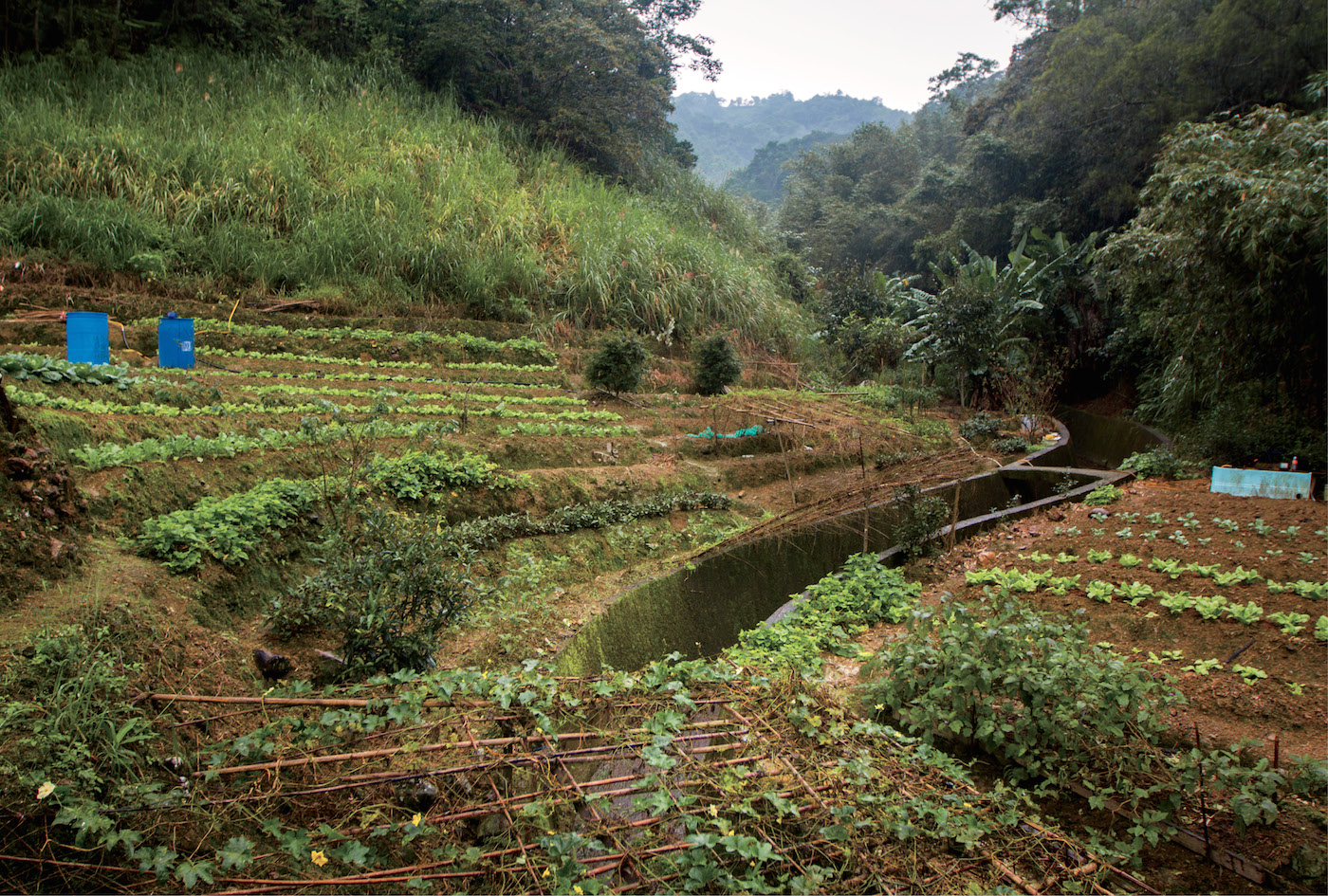
A lush farm in Ilan county
Image Gallery
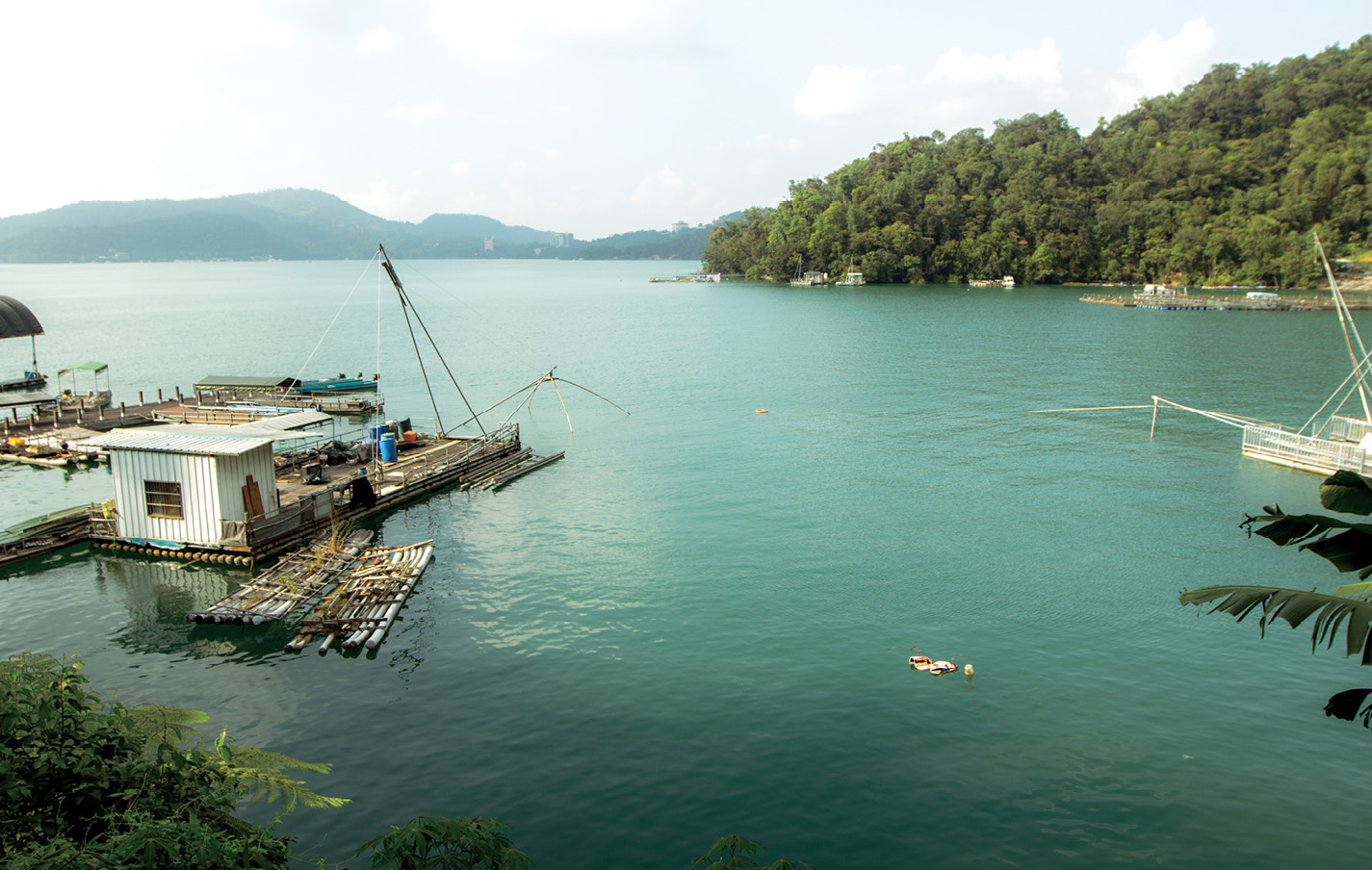
Boathouses on Sun Moon Lake
Image Gallery

A view from the mountains
Image Gallery

Water buffalo at a farm in Ilan county
Image Gallery

A thick forest in Sitou
Image Gallery

Paddle boarders on the beach
Image Gallery

A driftwood-strewn beach
Image Gallery
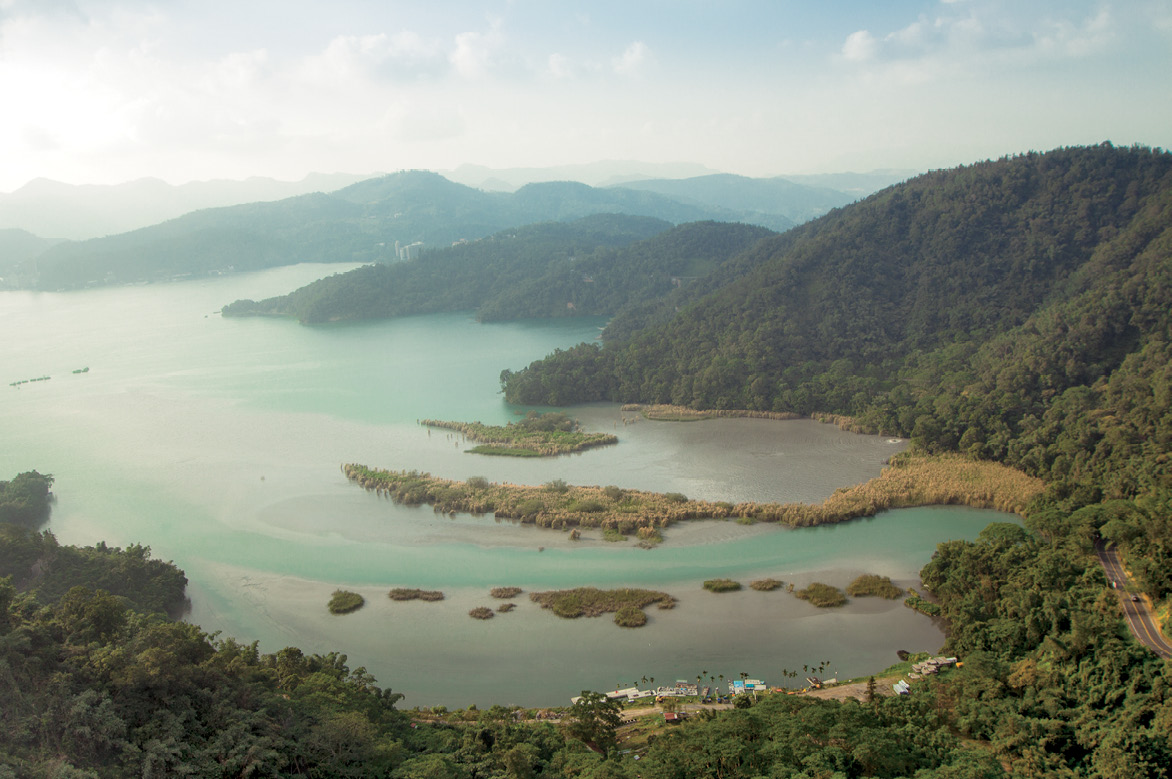
Sun Moon Lake
One can find all the ingredients for the recipes in this book in a well-stocked Asian supermarket. The Taiwanese pantry is not exorbitant: one need not stock up on numerous dried spices, pastes, and herbs. Here are some of the most common ingredients used in Taiwanese cooking. In the first recipe chapter, Sauces and Condiments, we will provide recipes for a few more.
Chili bean sauce
A signature condiment of Sichuan province, this sauce marries fermented beans and chilies in a pungent, pastelike mixture. Numerous variations exist: some may be studded with black soy beans while others, with yellow-colored fava beans, may be whole or mostly mashed up. Fermented bean sauce with or without the addition of chilies is also used in Taiwan; we’ll use a sweet, nonspicy fermented bean sauce called tienmianjiang to make zha jiang mian noodles. However, chili bean sauce is easiest to find in groceries in the U.S., and is widely used in Taiwanese cooking.
Cilantro
This distinctive herb is used liberally throughout Taiwan. Chopped—both stems and leaves, typically—it’s a ubiquitous garnish for soups, stir-fries and rice plates, adding a floral touch and color.
Cornstarch
Used to add clear, thick body to soups and sauces as well as to marinate meats and seafood, cornstarch is key in many Taiwanese recipes. Traditionally, the Taiwanese would use regular potato or arrowroot starch for these same purposes, but the common cornstarch found in the U.S. achieves the desired effects in these recipes, except where noted.
Crushed peanut powder
Like fried shallots, crushed peanuts are a savory, crunchy topping often used in Taiwan. Typically, the peanuts are ground to a finer consistency than one can achieve by simply chopping the nuts by hand, and they’re blended with sugar. This topping is seen in the Taiwanese steamed pork belly bun or gua bao, but it can also be sprinkled atop stir-fried dishes or sautéed vegetables for contrast.
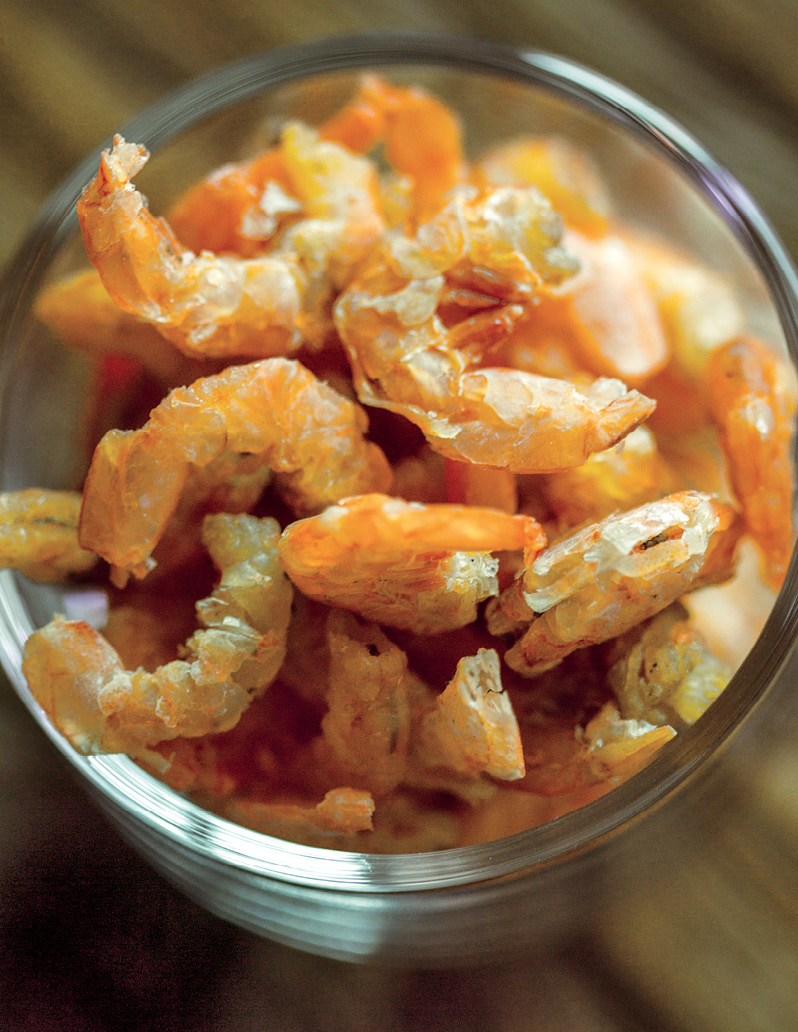
Dried shrimp
Dried baby shrimp
These little nuggets are full of briny umami flavor and are used, often soaked and minced, to flavor a wide variety of foods in Taiwan. They store well in an airtight container in the refrigerator, making them an easy option for a little extra flavor in a sautéed vegetable dish, for example.
Dried rice noodles
Taiwanese rice noodles are thin and delicate, unlike the flat, broad noodles of Thai dishes like pad thai. Rice is a staple crop of Taiwan, requiring much warmer climates than wheat, and this was the main type of noodles found on the island for centuries.
Dried shiitake mushrooms
Another common ingredient that packs a lot of flavor per portion. These dried mushrooms are best soaked for at least 30 minutes in cold or room-temperature water until spongy and fully reconstituted. Their resulting soaking water can be added to soups or used to flavor stir-fries.

Freshly made rice noodles
Dried wheat noodles
With the influence of mainland Chinese cuisines, wheat noodles have become popular in Taiwan, too. These may come in any variety of shapes and sizes, for any preference. One can also find fresh, hand-pulled wheat noodles from specialty shops and restaurants in Taiwan.
Fermented black beans
Salty and pungent, these whole beans are actually soy beans that have been fermented—not to be confused with the common black turtle bean. They are used throughout Chinese cuisines, and are related to soy sauce (which is brewed from fermented soy beans). Just a small pinch may be added to flavor stir-fries and braised dishes. If difficult to find, a dab of fermented black bean sauce—often found in jars as “black bean garlic sauce”—may be substituted.
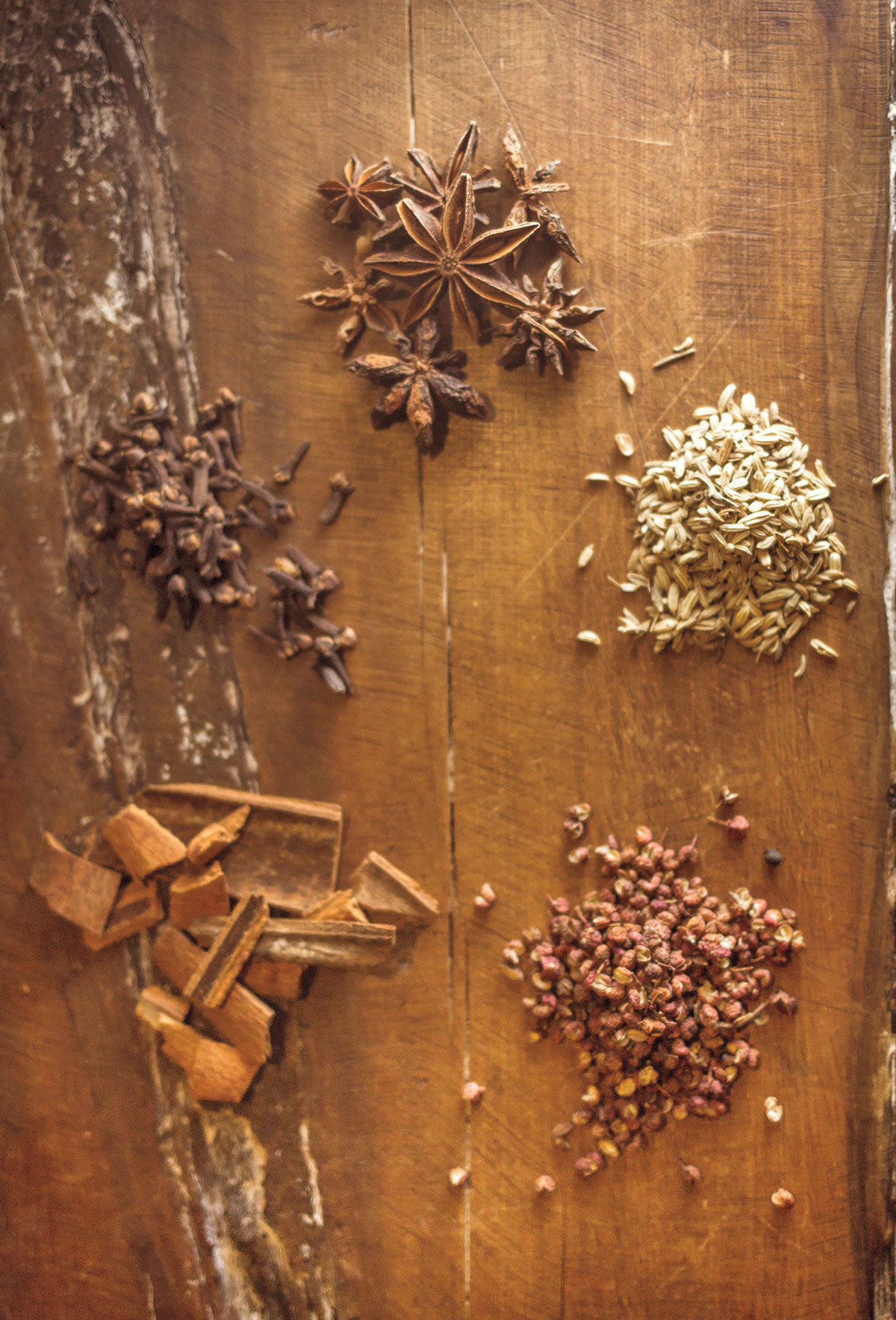
The spices in five-spice powder
Five-spice powder
A quintessential ingredient in red-braised stews, this is a ground spice blend of star anise, fennel seed, cinnamon, cloves, and Sichuan peppercorns, although variations and additional spices may occur.
Fresh chili sauce
Crushed, bright red chilies macerated in vinegar and salt, often with chopped garlic added, is an everyday condiment found in Taiwan. It can be added to the plate for dipping dumplings or buns, or used to add a touch of heat to stir-fries while cooking in the pan.
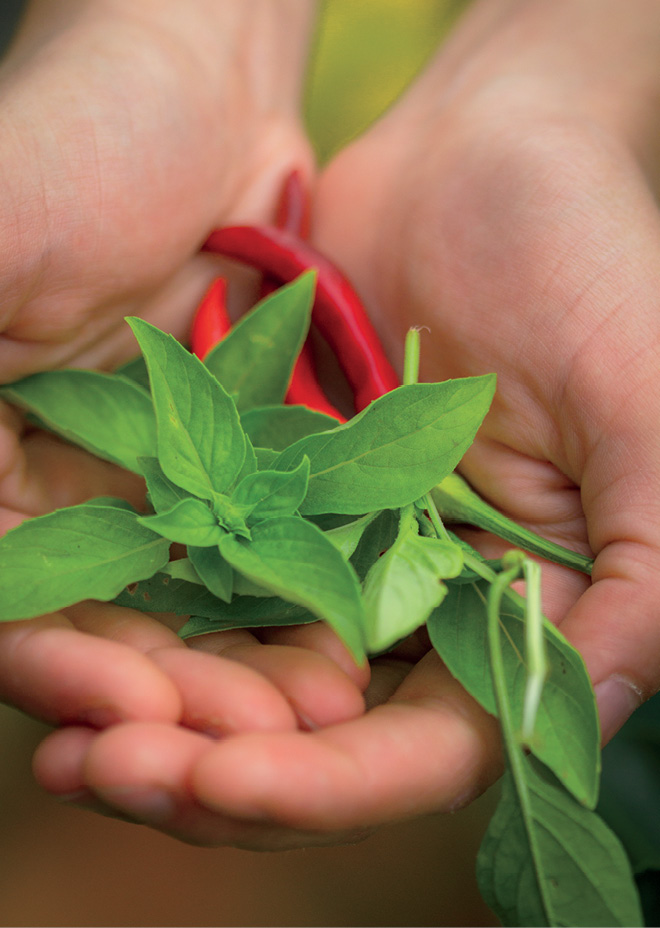
Thai basil and red chilies
Fresh chilies
Vibrant red chilies are used sparingly in Taiwanese cooking to add color and just a touch of heat. Commonly, these are large, finger-shaped bird’s eye, or Thai chilies, which have softened in heat level due to their ripe, red color.
Fresh Thai basil
Fragrant basil leaves are tossed in at the last moment to stir-fries in many famous Taiwanese dishes (like Three Cup Chicken). This basil variety has slightly serrated, spiky leaves and a somewhat more intense anise flavor than Italian basil, but in a pinch, Italian basil will do just fine for these recipes as a substitute.
Ginger
Fresh ginger root is a ubiquitous ingredient in Taiwanese cooking. The Taiwanese distinguish between “old” ginger root (with a rough, tan skin and fibrous interior) and “young” ginger, which is pearly pink and virtually skinless, with a crisp interior and milder taste. Young ginger is used mostly as a delicate garnish, whereas old ginger is more potent and often sliced up for stews and stir-fries. We will be referring to “old” ginger whenever ginger is mentioned in this book.
“Gourmet powder”
Most Taiwanese households have a small canister of this flavor enhancer, which is mostly MSG with white pepper and salt, and sometimes other spices added. However, I don’t call for this ingredient in any of the recipes in this book, opting for a combination of salt and white pepper or other spices as needed.
Ma-la chili oil
Dried chili peppers are crushed and cooked in oil with Sichuan peppercorns to make this unique condiment. The fusion of these ingredients create a numbing, hot sensation (ma-la) that’s both tingly and spicy. This condiment was not typical in Taiwan until after the mainland arrival of the mid-1900s. Today, however, Sichuan food enjoys great popularity in Taiwan and this condiment is often found at dumpling stands along with vinegar and soy sauce.
Rice vinegar
Taiwanese food often has a tinge of tanginess from natural rice vinegar. It may be clear, or aged so that it develops a warm, brownish tint. Black vinegar, an aged variety, is often used in Taiwan, and will have slightly less acidity and a sweeter taste than clear rice vinegars.
Rice wine
Not to be confused with rice vinegar, rice wine is used most often in stews and soups, or to marinate meats and seafood. Its slightly sweet, delicate flavor adds dimension to foods and is often thought to be a perfect counterbalance for strong-tasting seafood. It is perfectly acceptable to swap in Japanese rice wine (sake) if Taiwanese or Chinese rice wine is not to be found.
Sesame oil
Used throughout East Asia, this incredibly fragrant oil is made from toasted sesame seeds. The oil ranges from light tan to deep brown in color, depending on how well the seeds were toasted. Because of its rich flavor, it’s often used as a flavoring agent, such as to marinate meats, or drizzle atop dishes once they’re out of the wok, instead of for cooking.
Sha-cha sauce
This wonderfully savory sauce incorporates ground dried shrimp and fish along with shallots and dried chilies in oil, with a pastelike consistency. Although most households purchase the sauce in jars, I’ve provided a recipe for homemade sha-cha sauce.
Soy sauce
Dark soy sauce:
Darker and more robust than light soy sauce, dark soy sauce is often used in long-simmered dishes like red-braised pork, to add more distinctive color and deeper flavor.
Light soy sauce:
Not to be confused with low-sodium or “lite” soy sauces available on the market, light soy sauce simply means regular soy sauce in this book. It is more transparent, with less body, than dark soy sauce. It’s used in everything from stir-fries to quick sauces and dressings as a quintessential flavoring agent.
Thick soy sauce:
A starch-thickened, diluted, and slightly sweetened version of soy sauce, thick soy sauce is often used as a dip. Most Taiwanese homes have a bottle of it and even cook with the sauce in place of soy sauce, wherever a touch of sweetness and thickness is desired. It is similar to oyster sauce, which may be substituted.

Rock sugar
Sugar
A touch of sugar is common throughout Taiwanese recipes. In Taiwan, most households have natural clusters of “rock sugar” for cooking purposes (sugar is after all a major crop in Taiwan). However, natural, unbleached sugar or just white sugar may be used in any of the recipes instead.
Sweet potato or yam starch
Extracted from white sweet potatoes, this powder is a secret weapon for perfecting many signature Taiwanese dishes. It’s preferable over other starches to create a stiffer clear gel (like in oyster omelets) or a more crackly crust on fried foods (like fried chicken bites or oysters). It can be found in Asian supermarkets although precise labeling in English may be inconsistent; look for “sweet potato starch” or “yam starch” as it might otherwise be plain old potato starch, which won’t have the same effect.
White pepper
This everyday seasoning is used to season meats, seafood, eggs, and soup broths—much like ground black pepper in the Western tradition. The Taiwanese prefer white pepper for its unique flavor and because it doesn’t add dark specks to dishes, especially with light-colored foods. Sometimes, dishes call for a dusting of white pepper for garnish; canisters are commonly found at restaurant tables for this option as well.
White rice
Taiwanese rice tends to be short-grain and cooks up slightly more moist than long-grain white rice. However, long-grain or short-grain white rice are suitable for use in any of the recipes, unless noted.
Image Gallery

An old-fashioned cabinet
Image Gallery

A dried seafood vendor at a daytime outdoor food market
Image Gallery

Patrons lining up for a food cart
Image Gallery

A street vendor selling soup dumplings
Image Gallery

A cook at a seafood market kitchen
Image Gallery

Patrons enjoying a hot pot restaurant
Image Gallery

Grabbing a late night street snack
Image Gallery
